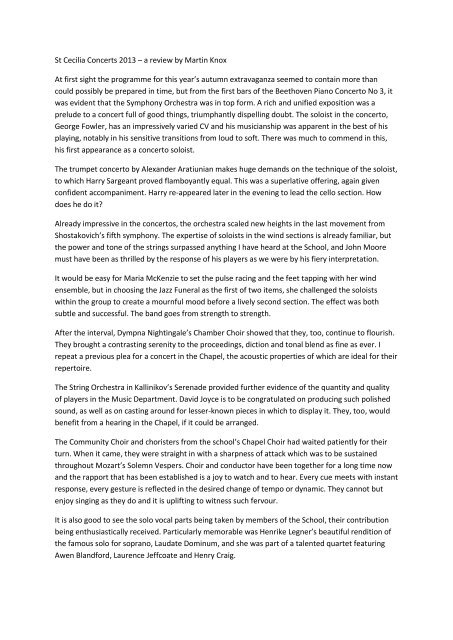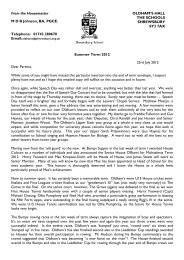review of the 2013 St Cecilia Concerts - Shrewsbury School
review of the 2013 St Cecilia Concerts - Shrewsbury School
review of the 2013 St Cecilia Concerts - Shrewsbury School
You also want an ePaper? Increase the reach of your titles
YUMPU automatically turns print PDFs into web optimized ePapers that Google loves.
<strong>St</strong> <strong>Cecilia</strong> <strong>Concerts</strong> <strong>2013</strong> – a <strong>review</strong> by Martin KnoxAt first sight <strong>the</strong> programme for this year’s autumn extravaganza seemed to contain more thancould possibly be prepared in time, but from <strong>the</strong> first bars <strong>of</strong> <strong>the</strong> Beethoven Piano Concerto No 3, itwas evident that <strong>the</strong> Symphony Orchestra was in top form. A rich and unified exposition was aprelude to a concert full <strong>of</strong> good things, triumphantly dispelling doubt. The soloist in <strong>the</strong> concerto,George Fowler, has an impressively varied CV and his musicianship was apparent in <strong>the</strong> best <strong>of</strong> hisplaying, notably in his sensitive transitions from loud to s<strong>of</strong>t. There was much to commend in this,his first appearance as a concerto soloist.The trumpet concerto by Alexander Aratiunian makes huge demands on <strong>the</strong> technique <strong>of</strong> <strong>the</strong> soloist,to which Harry Sargeant proved flamboyantly equal. This was a superlative <strong>of</strong>fering, again givenconfident accompaniment. Harry re-appeared later in <strong>the</strong> evening to lead <strong>the</strong> cello section. Howdoes he do it?Already impressive in <strong>the</strong> concertos, <strong>the</strong> orchestra scaled new heights in <strong>the</strong> last movement fromShostakovich’s fifth symphony. The expertise <strong>of</strong> soloists in <strong>the</strong> wind sections is already familiar, but<strong>the</strong> power and tone <strong>of</strong> <strong>the</strong> strings surpassed anything I have heard at <strong>the</strong> <strong>School</strong>, and John Mooremust have been as thrilled by <strong>the</strong> response <strong>of</strong> his players as we were by his fiery interpretation.It would be easy for Maria McKenzie to set <strong>the</strong> pulse racing and <strong>the</strong> feet tapping with her windensemble, but in choosing <strong>the</strong> Jazz Funeral as <strong>the</strong> first <strong>of</strong> two items, she challenged <strong>the</strong> soloistswithin <strong>the</strong> group to create a mournful mood before a lively second section. The effect was bothsubtle and successful. The band goes from strength to strength.After <strong>the</strong> interval, Dympna Nightingale’s Chamber Choir showed that <strong>the</strong>y, too, continue to flourish.They brought a contrasting serenity to <strong>the</strong> proceedings, diction and tonal blend as fine as ever. Irepeat a previous plea for a concert in <strong>the</strong> Chapel, <strong>the</strong> acoustic properties <strong>of</strong> which are ideal for <strong>the</strong>irrepertoire.The <strong>St</strong>ring Orchestra in Kallinikov’s Serenade provided fur<strong>the</strong>r evidence <strong>of</strong> <strong>the</strong> quantity and quality<strong>of</strong> players in <strong>the</strong> Music Department. David Joyce is to be congratulated on producing such polishedsound, as well as on casting around for lesser-known pieces in which to display it. They, too, wouldbenefit from a hearing in <strong>the</strong> Chapel, if it could be arranged.The Community Choir and choristers from <strong>the</strong> school’s Chapel Choir had waited patiently for <strong>the</strong>irturn. When it came, <strong>the</strong>y were straight in with a sharpness <strong>of</strong> attack which was to be sustainedthroughout Mozart’s Solemn Vespers. Choir and conductor have been toge<strong>the</strong>r for a long time nowand <strong>the</strong> rapport that has been established is a joy to watch and to hear. Every cue meets with instantresponse, every gesture is reflected in <strong>the</strong> desired change <strong>of</strong> tempo or dynamic. They cannot butenjoy singing as <strong>the</strong>y do and it is uplifting to witness such fervour.It is also good to see <strong>the</strong> solo vocal parts being taken by members <strong>of</strong> <strong>the</strong> <strong>School</strong>, <strong>the</strong>ir contributionbeing enthusiastically received. Particularly memorable was Henrike Legner’s beautiful rendition <strong>of</strong><strong>the</strong> famous solo for soprano, Laudate Dominum, and she was part <strong>of</strong> a talented quartet featuringAwen Blandford, Laurence Jeffcoate and Henry Craig.
As in every item in which <strong>the</strong>y were involved, <strong>the</strong> orchestra accompanied <strong>the</strong> choir magnificently.The amount <strong>of</strong> hard work that must go into a concert <strong>of</strong> this scale and this quality is enormous.Never has it sounded so worthwhile.





